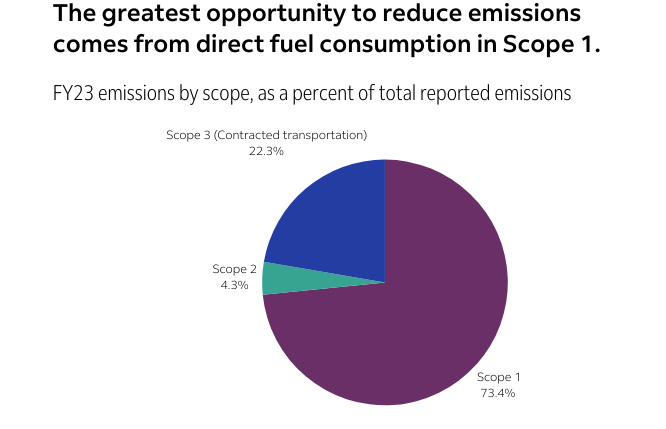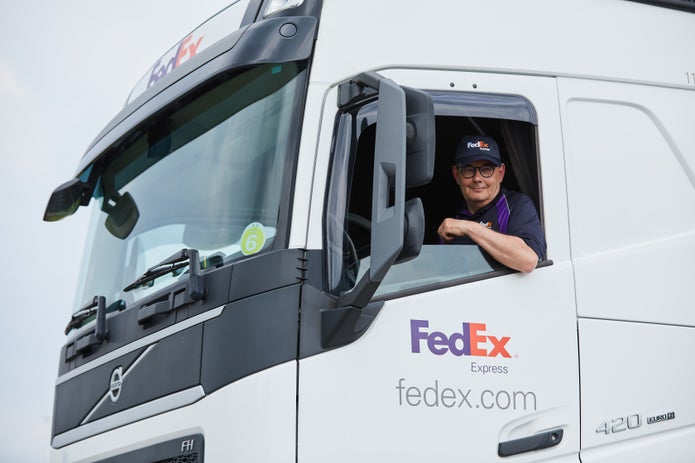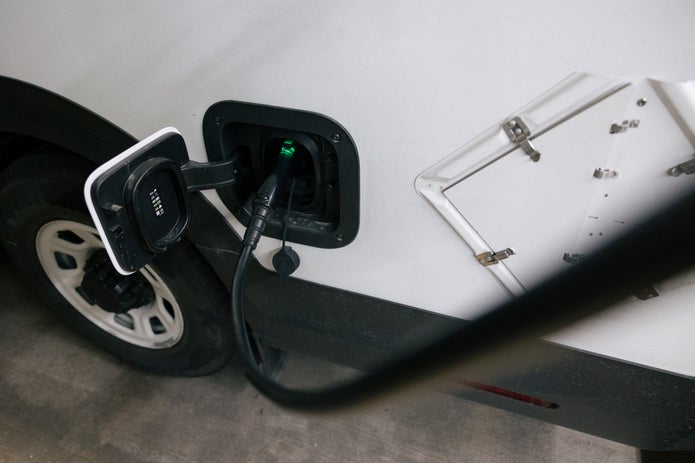Our roadmap to 2040
Driving innovation and efficiency in our operations
Improving the efficiency of our network is a key component of how FedEx is working to make supply chains smarter—and more sustainable—for everyone. We are working towards an enterprise-wide goal to achieve carbon-neutral operations globally by 2040.
Pursuing this goal presents opportunities to unlock greater efficiencies across our physical network, ultimately for the benefit of our customers, team members, communities, and the bottom line.
decrease in Scope 1 emissions
year-over-year (FY23 to FY24)
decrease in Scope 1 emissions year-over-year (FY23 to FY24)
See how we’re approaching our goal of carbon-neutral operations by 2040:
Our strategy
Our three-part strategy for reaching our 2040 goal prioritizes decarbonizing what is possible in our operations and co-creating with purpose to develop future solutions with a variety of stakeholders. Co-creation also underpins our efforts to neutralize what’s left with high-quality, durable carbon credits in the latter part of the next decade. We know that available technologies will not be able to eliminate all of our operational emissions, which is why we take a realistic view of the need to source high-quality, durable carbon credits to offset remaining emissions in the latter half of the next decade.
The FedEx business model is unique: FedEx owns a significant portion of our transportation assets. This means our emissions weigh heavily towards Scope 1 emissions—known as “direct emissions”—from operating these owned aircraft and vehicles, as well as Scope 2 “indirect emissions” from purchased electricity at our facilities.
Our three-part strategy for reaching our 2040 goal prioritizes decarbonizing what is possible in our operations and co-creating with purpose to develop future solutions with a variety of stakeholders. Co-creation also underpins our efforts to neutralize what’s left with high-quality, durable carbon credits in the latter part of the next decade.
We know that available technologies will not be able to eliminate all of our operational emissions, which is why we take a realistic view of the need to source high-quality, durable carbon credits to offset remaining emissions in the latter half of the next decade.
The FedEx business model is unique: FedEx owns a significant portion of our transportation assets. This means our emissions weigh heavily towards Scope 1 emissions—known as “direct emissions”—from operating these owned aircraft and vehicles. In 2025, we expanded the completeness of our measured footprint, particularly with Scope 3 emissions.
Reducing emissions in our operations
Aviation: An "all of the above" approach
About 80 percent of our direct Scope 1 emissions comes from the use of jet fuel in our fleet of approximately 700 aircraft. Beyond efforts to reduce fuel usage overall through conservation programs and fleet modernization, we continue to advocate for greater quantities of cost-effective, lower-emissions alternative fuels.
Our goals
- By 2030: Obtain 30% of jet fuel from alternative sources (blended)
- By 2034: Reach a 40% reduction in aircraft emissions intensity from a 2005 baseline
- By 2030: Obtain 30% of jet fuel from alternative sources (blended)
- By 2034: Reach a 40% reduction in aircraft emissions intensity from a 2005 baseline
Our approach
Reducing overall jet fuel consumption through fuel conservation initiatives and operational efficiencies
Reducing overall jet fuel consumption through fuel conservation initiatives and operational efficiencies
Replacing older aircraft with more efficient models
Replacing older aircraft with more efficient models
Exploring available alternative jet fuel options
Exploring available alternative jet fuel options
Our results*
31% reduction in overall aircraft emissions intensity from a 2005 baseline, as of FY24
31% reduction in overall aircraft emissions intensity from a 2005 baseline, as of FY24
983 million gallons of jet fuel and 9.6 MMT of CO2e avoided since 2006 through 70 different Fuel Sense fuel-saving projects
983 million gallons of jet fuel and 9.6 MMT of CO2e avoided since 2006 through 70 different Fuel Sense fuel-saving projects
130 million gallons of jet fuel and 1.2 MMT of CO2e avoided from fleet modernization initiatives in FY24, equivalent to about $370 million in savings
130 million gallons of jet fuel and 1.2 MMT of CO2e avoided from fleet modernization initiatives in FY24, equivalent to about $370 million in savings
Just landed at LAX: Sustainable Aviation Fuel (SAF)
In a first for our U.S. operations, we are now using blended sustainable aviation fuel (SAF) to help fuel FedEx aircraft at Los Angeles International Airport (LAX), as part of a one-year agreement securing more than 3 million gallons with a minimum 30% neat SAF blend. Securing and using SAF is part of our strategy towards our goal of carbon neutral global operations by 2040.
Vehicles: Right solution, right application
Our ground fleet of more than 200,000 vehicles includes everything from forklifts to tractor-trailers to the vans making last-mile deliveries in your neighborhood. We work to match the right vehicle technology with available infrastructure and the needs of our network.
Our goals
- By 2025: Target 50% of owned parcel pickup and delivery vehicle purchase orders to be electric vehicles
- By 2030: Aim for 100% of owned parcel pickup and delivery vehicles purchase orders to be electric vehicles
- By 2040: Have all parcel pickup and delivery vehicles be zero-tailpipe emissions models, including contracted transportation
- By 2025: Target 50% of owned parcel pickup and delivery vehicle purchase orders to be electric vehicles
- By 2030: Aim for 100% of owned parcel pickup and delivery vehicles purchase orders to be electric vehicles
- By 2040: Have all parcel pickup and delivery vehicles be zero-tailpipe emissions models, including contracted transportation
Our approach
Reducing miles driven and fuel used through:
- Taking a phased approach to electrify our parcel pickup and delivery fleet worldwide
Taking a phased approach to electrify our parcel pickup and delivery fleet worldwide
- Testing and deploying alternative fuels, like biofuels
Testing and deploying alternative fuels, like biofuels
- Transitioning ground service equipment (GSE) to electric or alternative fuels
Transitioning ground service equipment (GSE) to electric or alternative fuels
- Installing charging infrastructure
Installing charging infrastructure
- Optimizing routes
Optimizing routes
- Shifting select volumes to lower-emissions modes of transport
Shifting select volumes to lower-emissions modes of transport
Our results*
- More than 1,000 electric parcel pickup and delivery vehicles deployed across six continents
More than 1,000 electric parcel pickup and delivery vehicles deployed across six continents
- More than 8,000 on- and off-road electric vehicles as of FY24
More than 8,000 on- and off-road electric vehicles as of FY24
On the road with FedEx: EVs in California
See how a courier operates a FedEx electric vehicle, or EV, on her day-to-day route. Go “On the Road” with courier and trainer Megan as she makes deliveries around Sacramento in one of our EVs.
Shifting gears from diesel to drop-in alternative fuels
Thanks to battery physics, filling up the tank of a heavy-duty truck with a lower-emissions fuel may be a smarter option than electrification. In the UK, FedEx recently switched from diesel to 100% hydrotreated vegetable oil (HVO) to power linehaul trucks at three key locations, with at least 80% lifecycle carbon emissions savings versus traditional diesel.
Facilities: More efficiency, greater resilience
Across our approximately 5,000 facilities worldwide, we look for ways to improve energy efficiency at each part of a building’s lifecycle. We also source additional renewable energy at these facilities to meet increased electricity demand from EV charging and to strengthen operational resilience.
Our goals
- Ongoing: Seek LEED or BREEAM certification on all new buildings, where appropriate
- By 2028: Source 500GWh from renewable energy sources
- By 2033: Source 1,300 GWh from renewable energy sources
- By 2040: Source 100% of facility energy from renewable energy sources
- Ongoing: Seek LEED or BREEAM certification on all new buildings, where appropriate
- By 2028: Source 500GWh from renewable energy sources
- By 2033: Source 1,300 GWh from renewable energy sources
- By 2040: Source 100% of facility energy from renewable energy sources
Our approach
- Installing energy efficient lighting
Installing energy efficient lighting
- Designing, constructing, and retrofitting facilities with efficiency in mind
Designing, constructing, and retrofitting facilities with efficiency in mind
- Sourcing more on- and off-site renewable energy
Sourcing more on- and off-site renewable energy
- Developing microgrids for enhanced resilience
Developing microgrids for enhanced resilience
Our results*
- Renewable energy procurement
- 34 on- and off-site solar installations generated enough renewable energy, avoiding 9,783 metric tons of CO2e emissions
Renewable energy procurement
- 34 on- and off-site solar installations generated enough renewable energy, avoiding 9,783 metric tons of CO2e emissions
- Lighting retrofits and energy management systems:
- Saved more than 240 million kilowatt hours of electricity in FY24
- Avoided over 168,545 metric tons of CO2e emissions
Lighting retrofits and energy management systems:
- Saved more than 240 million kilowatt hours of electricity in FY24
- Avoided over 168,545 metric tons of CO2e emissions
- Facility standards
- Facilities across 26 countries and territories maintaining compliance with the ISO 14001 environmental management system standard
Facility standards
- Facilities across 26 countries and territories maintaining compliance with the ISO 14001 environmental management system standard
Centering the community in ‘community solar’
At a FedEx facility in the heart of Washington, D.C., a nearly-1 mW rooftop solar installation generates additional renewable energy for residents of the nation’s capital—and supports a local non-profit at the same time.
Co-create with purpose: Predicting future electricity demand
FedEx supported RMI’s launch of “GridUp,” a tool that estimates where future electricity demand from electric vehicles will materialize. This information helps utilities, regulators, policymakers, and fleet operators develop and implement charging infrastructure projects to help save money and time.
Neutralizing what's left
Available technologies will not eliminate our operational emissions entirely. We take a realistic view of the need to source high-quality, durable carbon credits to offset remaining emissions in the latter half of the next decade.
Taking action through collaboration
To accelerate the science needed to find scalable solutions that can permanently capture and store carbon, FedEx committed $100 million to help establish the Yale Center for Natural Carbon Capture. Now in its third year, the Center is researching carbon sequestration.
Want to checkout your carbon footprint? You can view estimated CO2e* shipping emissions at package and account levels with FedEx® Sustainability Insights.
Want to checkout your carbon footprint? You can view estimated CO2e* shipping emissions at package and account levels with FedEx® Sustainability Insights.
*Source: 2025 Corporate Responsibility Report (Unless otherwise noted, data covers each of our operating companies and all geographies in our 2024 fiscal year, which ended May 31, 2024.)


.png)




